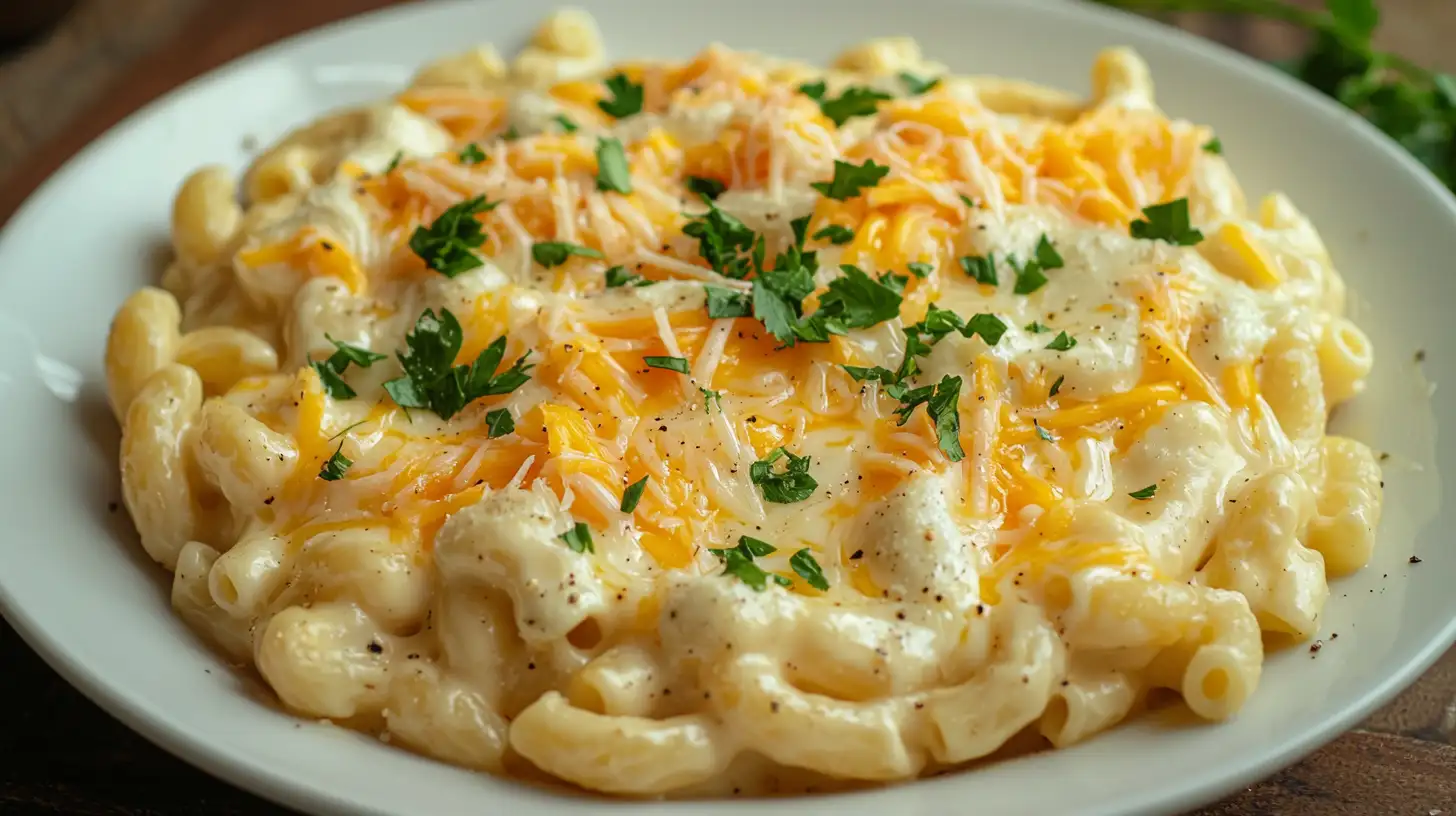Introduction
Looking for a healthy twist on your favorite comfort food that still delivers the creamy, cheesy goodness you crave? This protein mac and cheese is exactly that. Made with real ingredients like cottage cheese, protein pasta, and a foolproof blend of cheeses, this recipe packs in serious nutrition without losing any flavor. Whether you’re feeding your family or fueling up after a workout, it’s balanced, satisfying, and ready in minutes. Forget the grainy, bland versions out there. This one brings rich texture, bold taste, and over 40 grams of protein per serving. It’s a star recipe from our ultimate guide to high-protein dinners, where we prove that comfort food can be both healthy and delicious.
Table of Contents
Why This Protein Mac and Cheese Recipe is the Best
Ultra-creamy and packed with protein
I still remember the first time I tried swapping out traditional heavy cream with blended cottage cheese. It was in my tiny apartment kitchen, during a week when I was experimenting with healthier comfort meals. I had no idea that one simple substitution would transform the way I make mac and cheese.
The first bite? Smooth, savory, and shockingly rich in protein. It wasn’t just good, it was better than any boxed version and didn’t leave me feeling weighed down. That’s when I knew this recipe would be a staple in my kitchen, and hopefully in yours too.
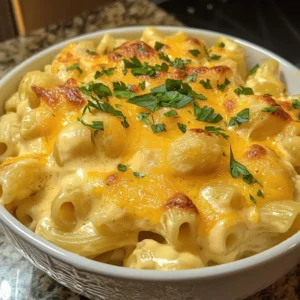
The Ultimate Best Protein Mac And Cheese (Creamy & 40g Protein)
Ingredients
- 8 oz protein pasta like Banza or Barilla Protein Plus
- 1 cup full-fat cottage cheese blended
- 1½ cups shredded sharp cheddar cheese
- ½ cup milk dairy or unsweetened plant-based
- 1 tsp Dijon mustard
- ½ tsp garlic powder
- Salt and pepper to taste
- Optional: ¼ cup Greek yogurt
- Optional: 1–2 tbsp unflavored whey protein
- Optional: paprika chili flakes, or steamed broccoli
Instructions
- Cook protein pasta until al dente, drain, and set aside.
- In a blender, combine cottage cheese, milk, Dijon, garlic powder, salt, and pepper.
- Blend until smooth and creamy.
- Shred cheddar cheese and set aside.
- Pour blended mixture into a skillet over medium-low heat.
- Warm gently, then gradually stir in shredded cheese until melted.
- Add cooked pasta and stir until fully coated.
- Adjust consistency with milk if needed. Add optional ingredients now.
- Serve hot and garnish with paprika or fresh herbs.
Notes
Nutrition
Protein-rich and guilt-free
This high protein mac and cheese hits all the right notes for a quick, satisfying, and macro-balanced meal. With over 40 grams of protein per serving, it’s a no-brainer for fitness-focused eaters, busy parents, or anyone craving comfort without compromise.
Creamy, never grainy
Using blended cottage cheese guarantees a silky sauce every time. No more clumps or oily separation like you get with some protein powder versions.
Fast and flexible
From one-pot prep to baked casseroles, this dish adapts to your schedule and your cravings. You can even double the batch and freeze portions for easy meal prep.
Perfect balance of macros
With just the right ratio of protein, complex carbs, and fats, it’s ideal for keeping energy steady while satisfying that craving for something cozy.
Kid-friendly and picky-eater approved
Even the littlest critics won’t suspect it’s secretly packed with protein. This recipe turns out creamy, cheesy, and downright craveable.
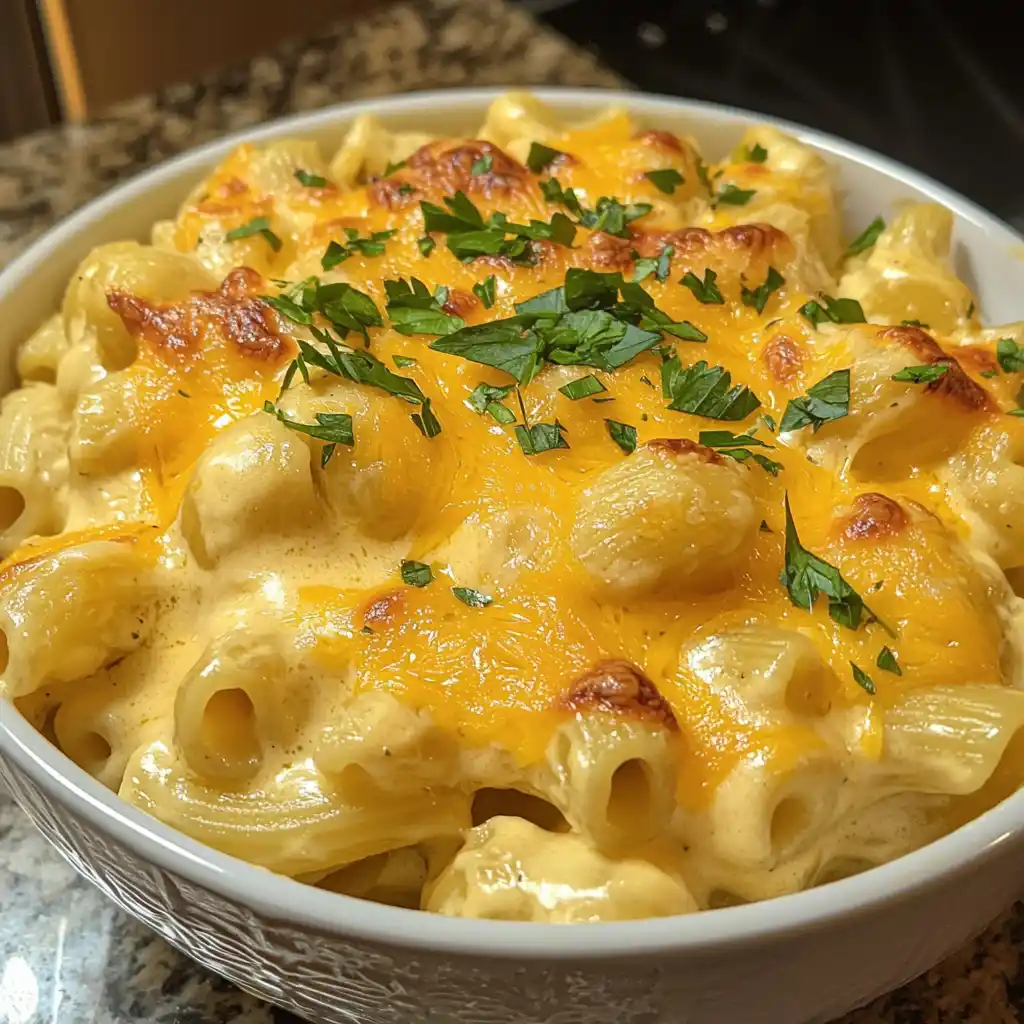
The “Kitchen Science” Behind the Perfect Creamy Sauce
Why cottage cheese is the secret to ultra-creamy protein mac and cheese
Let’s talk about the ingredient that makes this recipe truly game-changing: cottage cheese. Not just any cottage cheese, full-fat, small curd, blended until smooth. This single swap replaces heavy cream, cream cheese, and butter while giving you a rich texture and a powerful protein boost.
The high casein content in cottage cheese makes it an excellent thickening agent when warmed carefully. Through blending, it transforms into a creamy, velvety foundation that coats noodles similarly to classic white sauce. The secret lies in processing it until completely smooth, eliminating any chunky bits or gritty consistency.
In my test kitchen, I tried versions with cream, milk, and even Greek yogurt, but nothing matched the creamy consistency that blended cottage cheese provides. And because it’s so neutral in flavor, it lets the sharpness of cheddar or the tang of Parmesan shine without overpowering the dish.
Avoiding the dreaded grainy sauce
If you’ve ever had a protein-packed mac and cheese turn grainy or separate, you’re not alone. That usually happens when dairy proteins are overheated, causing them to curdle or break apart. The solution? Keep the heat medium-low when mixing your blended sauce with pasta. Stir gently and avoid letting the pot boil.
This is also where the magic of low-moisture cheeses like sharp cheddar comes into play; they melt smoothly without breaking, unlike higher-moisture shredded cheese blends.
Looking to learn more about how protein impacts digestion and daily intake? The Mayo Clinic offers expert-backed insight into how much protein you need, especially if you’re adjusting your macros.
If you enjoy creamy textures that pack in nutrition, you’ll love our Pizza Bowl with cottage cheese, too; it follows the same delicious science.
Ingredients You’ll Need
The best ingredients for high protein mac and cheese
What sets this high protein mac and cheese apart isn’t just what’s in it; it’s the careful choice of each ingredient. Here’s what you need and why it matters:
- Cottage Cheese (1 cup blended)
This is your creamy base and major protein booster. Choose full-fat cottage cheese for the richest texture. Blend it smooth to avoid lumps. Low-fat versions work, but the sauce may be thinner.
- Cheddar Cheese (1½ cups shredded)
Sharp cheddar melts well and adds depth. A combination of sharp cheddar and white cheddar can elevate the flavor even more. Avoid pre-shredded cheese if possible, since it contains anti-caking agents that prevent smooth melting.
- Protein Pasta (8 ounces)
Brands like Banza (made from chickpeas) or Barilla Protein Plus add even more protein per bite and come with the bonus of added fiber. Chickpea pasta is also gluten-free and has a pleasant nutty flavor.
- Milk (½ cup)
Helps thin the sauce to your preferred consistency. Use unsweetened almond milk, dairy milk, or even a splash of oat milk, depending on your preference. Just avoid flavored varieties, which can throw off the taste.
- Greek Yogurt (¼ cup, optional)
A spoonful of full-fat Greek yogurt adds extra protein and tang. It pairs well with sharp cheddar and rounds out the creaminess.
- Unflavored Protein Powder (optional, 1–2 tablespoons)
If you’re aiming for max protein, a scoop of unflavored whey isolate can be stirred in at the end. Make sure to use a clean, heat-stable powder to prevent clumping or bitterness.
Spices and Flavor Boosters
- Dijon mustard (1 teaspoon) for tang
- Garlic powder (½ teaspoon) for depth
- Paprika (¼ teaspoon) for a subtle smoky note
- Salt and pepper to taste
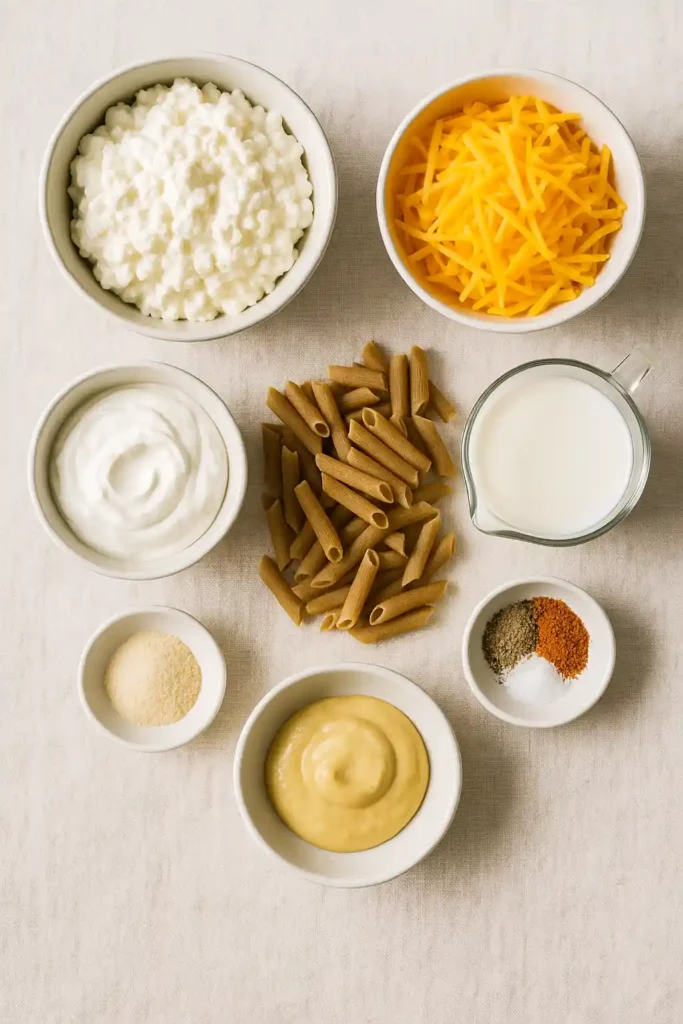
Optional Add-ins
- Frozen peas or steamed broccoli
- Cooked shredded chicken
- Dash of hot sauce for a spicy version
This combination creates a creamy, rich sauce that’s anything but bland. If you’re exploring more ways to build flavor in healthy meals, you’ll find inspiration in our high protein meal prep bowls.
How to Boost the Protein: A Complete Guide
Choosing the right ingredients for a macro-balanced, high protein mac and cheese
This recipe already delivers a solid protein punch, but if you want to raise the numbers even more for muscle recovery, fat loss, or just satiety, here’s a breakdown of your best options.
Each add-in has unique benefits and a few things to consider. Below is a side-by-side comparison to help you find the right combo for your goals and taste preferences.
Protein Boost Comparison Table
| Protein Booster | Protein per 1/2 Cup or Serving | Pros | Cons |
|---|---|---|---|
| Blended Cottage Cheese | 14g | Ultra creamy, mild flavor | Must blend for smooth texture |
| Greek Yogurt | 10g | Adds tang, high protein | Can overpower if overused |
| Unflavored Whey Protein | 20–25g (1 scoop) | Biggest protein boost | Texture and taste can be tricky |
| Protein Pasta (Banza, Barilla Plus) | 13–20g per serving | Easy swap, fiber-rich | Slightly different texture |
Combining strategies for best results
You don’t have to pick just one. For the ultimate creamy, high protein mac and cheese, try blending cottage cheese as the base, mixing in Greek yogurt for tang, and using protein pasta. If you’re training hard or want to prep a post-gym meal, a scoop of unflavored whey isolate can boost your total to 45–50g of protein per bowl.
How to Make Protein Mac and Cheese (Step-by-Step)
Follow these steps for creamy, high protein mac and cheese every time
The secret to a creamy, lump-free high-protein mac and cheese is in the prep. Here’s a simple guide to ensure every batch is rich, smooth, and full of flavor.
- Cook the pasta
Bring salted water to a vigorous boil in a large pot, using plenty of salt to season the water well. Toss in the protein pasta and cook it until just tender, following the instructions on the package. Once done, drain the pasta but skip rinsing; it’s best to keep the natural starch so the sauce sticks better. - Blend the sauce base
In a blender, combine:
- 1 cup full-fat cottage cheese
- ½ cup milk (dairy or unsweetened plant-based)
- 1 teaspoon Dijon mustard
- ½ teaspoon garlic powder
- Salt and pepper to taste
Blend until completely smooth and creamy. This forms the protein-rich base for your sauce.
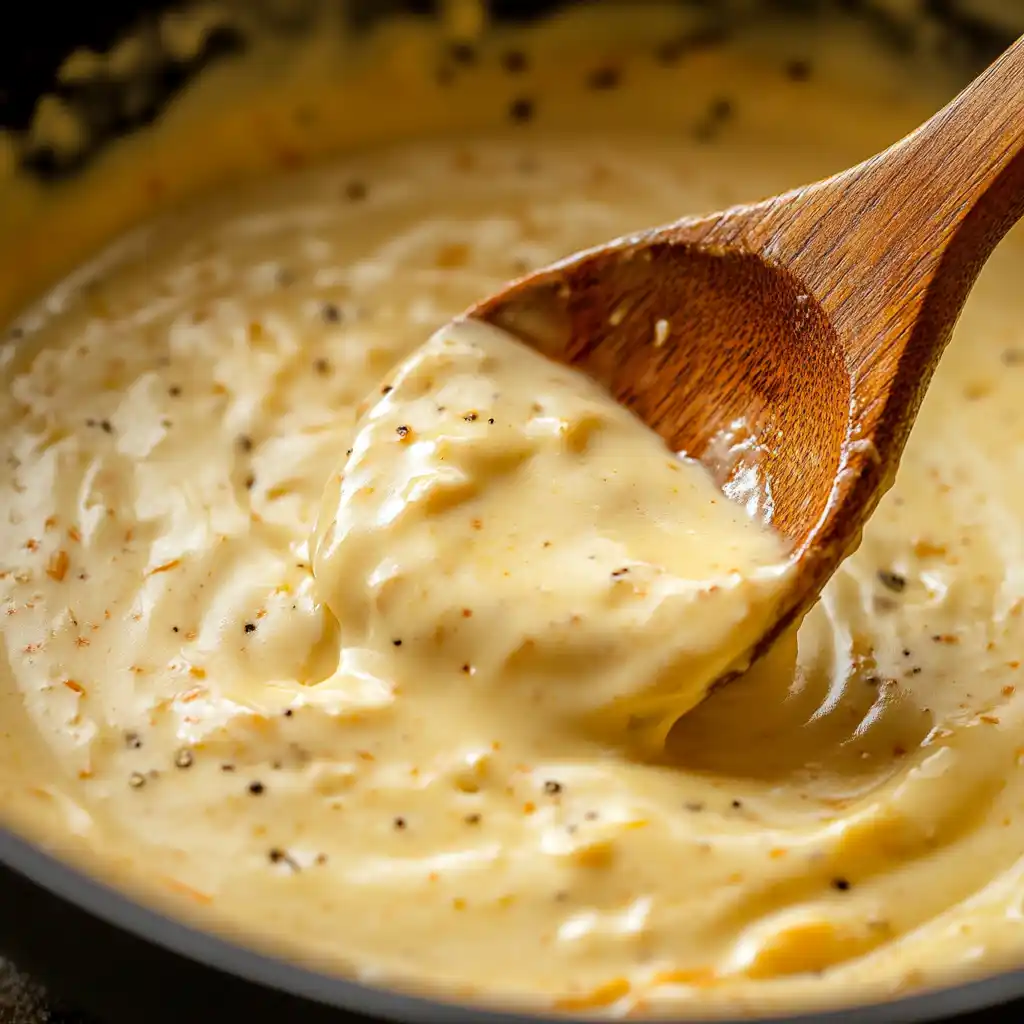
- Shred the cheese
Grate 1½ cups of sharp cheddar (or mix with Monterey Jack or white cheddar). Freshly shredded cheese melts better and avoids clumping. - Warm the sauce gently
In a large skillet over medium-low heat, pour in the blended cottage cheese mixture. Stir frequently and let it warm for 2–3 minutes. Do not boil. - Melt the cheese
Gradually sprinkle in the shredded cheese, adding one handful at a time and stirring well after each addition. Maintain low heat throughout to avoid curdling. When all the cheese has melted smoothly, give it a taste and tweak the seasoning as needed. - Combine with pasta
Transfer the cooked pasta straight into the skillet and stir until it’s well coated with the sauce. If the mixture feels too thick, add a small splash of milk to loosen it. If it’s too runny, let it simmer on low heat for another minute or two to thicken up. - Optional: Add-ins
At this stage, stir in extras like steamed broccoli, grilled chicken, or chili flakes if desired. - Serve hot and creamy
Spoon the pasta into individual bowls and garnish with a sprinkle of paprika or freshly ground black pepper. Serve immediately to enjoy optimal taste and consistency.
Troubleshooting Guide: Ensuring a Perfect Sauce Every Time
Fix the most common problems with protein mac and cheese
Even with the best ingredients, mac and cheese can sometimes turn out less than perfect. Here’s how to fix those issues quickly, so every bowl is smooth, creamy, and crave-worthy.
Problem 1: My sauce turned out grainy or clumpy
This typically happens when the dairy gets too hot or if the cottage cheese wasn’t blended to a smooth consistency.
How to fix it:
- Always blend the cottage cheese until completely smooth.
- Melt cheese over low heat and never let the sauce boil.
- Stir gently and consistently as it warms.
Problem 2: The sauce is too thick
Protein-rich components tend to set rapidly, particularly when the mixture begins to cool down.
How to fix it:
- Add a splash of heated milk or reserved cooking liquid from the pasta, then whisk until the blend reaches a creamy, uniform consistency.
- Cover the pot while off heat to retain moisture if you’re not serving right away.
Problem 3: The sauce is too thin
Too much liquid or not enough cheese can lead to a watery texture.
How to fix it:
- Simmer the sauce gently until it reduces slightly.
- Add more shredded cheese, a little at a time.
- A spoonful of Greek yogurt can also help thicken it while adding protein.
Problem 4: It tastes bland
Reduced-fat cheese varieties or unflavored protein supplements may diminish the overall taste.
How to fix it:
- Mix in Dijon mustard, a dash of hot sauce, or a sprinkle of smoked paprika.
- Try aged cheddar or a sharp cheese blend for more bite.
- Dried garlic, onion powder, and a touch of cayenne pepper can work magic for flavor enhancement.
Problem 5: It dried out after reheating
Microwaving or stovetop reheating can dry out pasta dishes quickly.
How to fix it:
- Add a splash of milk before reheating.
- Use a lid or microwave-safe covering to preserve moisture content.
- Stir halfway through to evenly distribute heat.
This troubleshooting section ensures your high protein mac and cheese isn’t just nutritious, it’s reliably delicious every time.
Must-Try Variations of protein mac and cheese
Customize your high protein mac and cheese with bold, flavorful twists
One of the best parts about this protein mac and cheese is how easily you can adapt it to fit your taste, macros, or pantry. Whether you’re feeding kids, meal prepping, or spicing things up, these simple variations offer flavor without compromise.
Baked Protein Mac and Cheese
Looking for a crunchy, browned finish? Move your completed mac and cheese to a buttered casserole dish.
- Top with a mix of ¼ cup panko breadcrumbs, 1 tablespoon olive oil, and 2 tablespoons grated Parmesan.
- Cook in a 400°F oven for 10–12 minutes until bubbling and golden on top.
This version feels indulgent but still aligns with your high protein goals. Try pairing it with a roasted veggie tray bake for a balanced dinner.
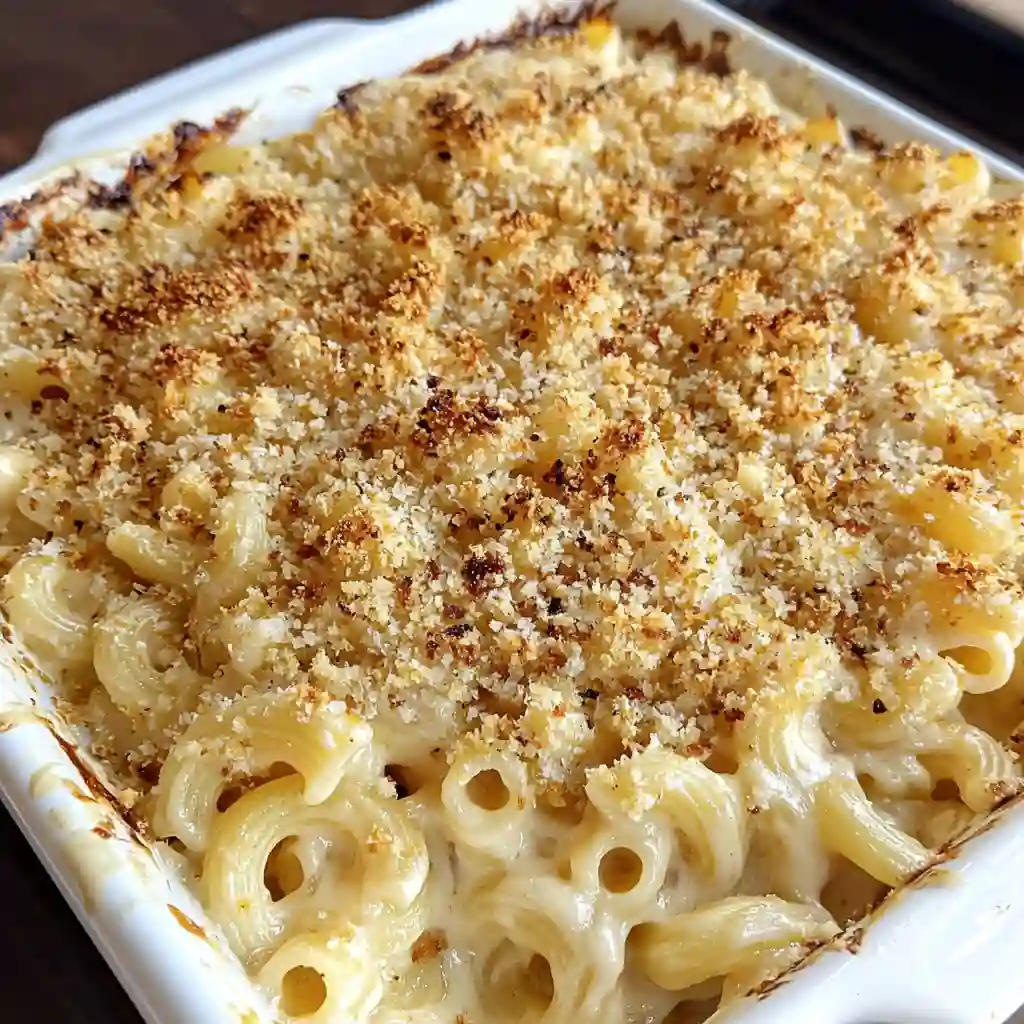
Spicy Mac and Cheese
If you like heat, this variation is for you.
- Add ¼ teaspoon red chili flakes or a chopped jalapeño into the sauce while it simmers.
- For smoky heat, stir in ½ teaspoon chipotle powder or a few dashes of your favorite hot sauce.
Top with sliced green onions and serve with grilled chicken or tofu.
Chicken and Broccoli Mac
This is a go-to meal prep favorite in our house.
- Stir in 1 cup of steamed broccoli florets and ¾ cup of cooked, shredded chicken at the end.
- Add a little extra cheese or Greek yogurt to keep the sauce creamy with the added ingredients.
It’s comforting, complete, and kid-approved.
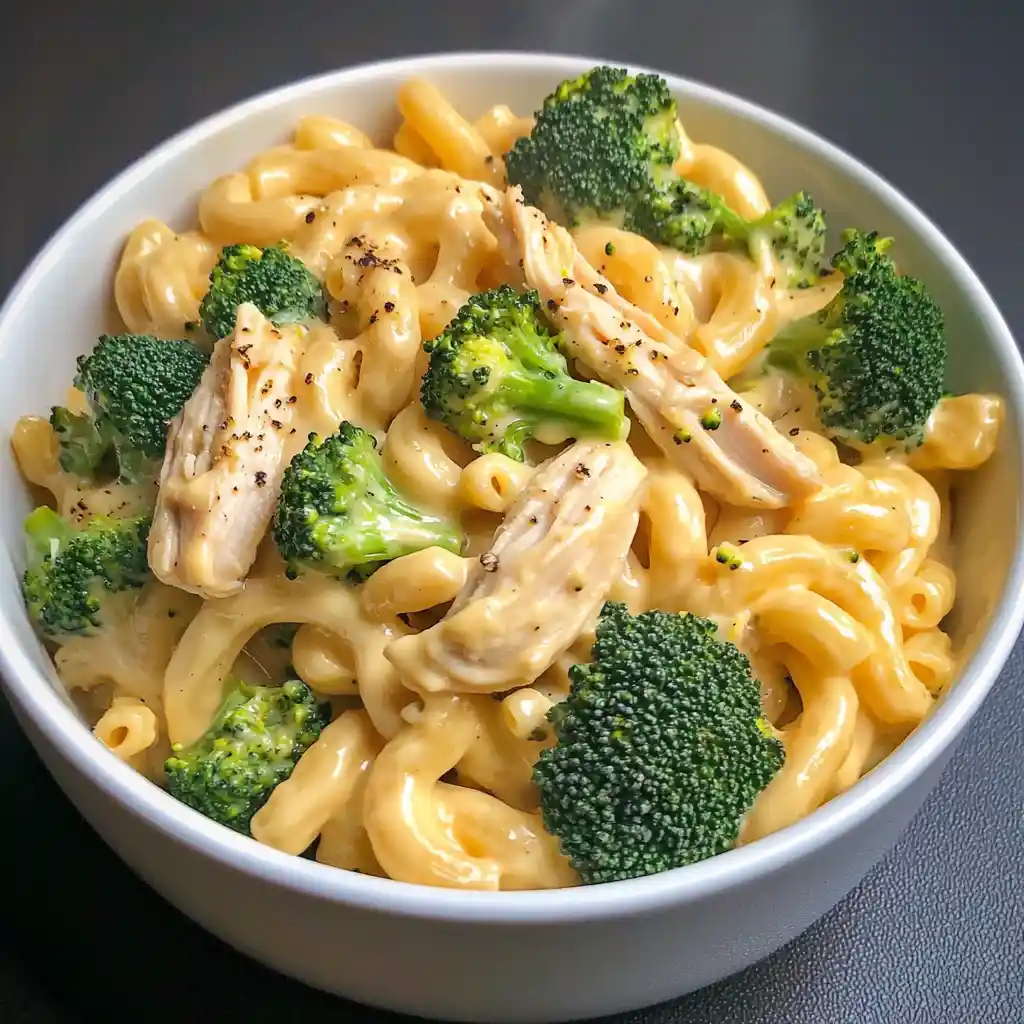
Buffalo Style Protein Mac
Add 1–2 tablespoons of buffalo sauce to the cheese blend and top with crumbled blue cheese or Greek yogurt-based ranch drizzle. Perfect for game day or a crave-worthy lunch.
Mac and Cheese with Cottage Cheese Topping
Want even more cottage cheese love? Blend some cottage cheese with garlic powder and herbs, then dollop it on top before baking for a rich, protein-stacked finish. It’s similar to our cottage cheese pizza bowl and just as satisfying.
No matter which way you go, these variations ensure you never get bored with your high protein meals, and keep your comfort food cravings totally satisfied.
Storage, Freezing, and Reheating Instructions
Keep your protein mac and cheese fresh, creamy, and meal-prep ready
This dish isn’t just great fresh; it stores and reheats beautifully when done right. Whether you’re prepping ahead or saving leftovers, here’s how to keep the texture smooth and the flavor intact.
How to store leftovers
Let the mac and cheese cool completely, then transfer to an airtight container.
- Fridge: Store for 3 to 5 days
- Best containers: Use glass containers with tight-fitting lids to prevent drying out
If you plan to enjoy it for lunch or dinner during the week, portioning it into individual servings makes it easy to grab and go.
How to reheat without drying out
Protein-rich sauces tend to thicken or firm up when chilled. Here’s how to bring back the creaminess:
- Microwave: Add a splash of milk (1–2 tablespoons), cover loosely, and heat in 30-second intervals. Stir between rounds to distribute heat.
- Stovetop: Add a bit of milk to a small pan, stir in the pasta, and reheat on low heat while stirring.
For best results, don’t overheat. Gentle warming is key to keeping the texture creamy and smooth.
Can you freeze protein mac and cheese?
Yes, but the method matters.
- Best option: Freeze the sauce separately from the pasta in zip-top bags or freezer-safe containers. This prevents the pasta from getting mushy.
- To use: Thaw in the fridge overnight and reheat gently on the stove with a splash of milk.
Tip: Freeze the sauce in ice cube trays for quick, single-serve reheating. Just toss a cube or two into freshly cooked protein pasta for a fast, high-protein meal.
Conclusion
If you’re looking for comfort food that aligns with your wellness goals, this protein mac and cheese delivers perfectly. It’s rich, delicious, and loaded with more than 40 grams of protein in each portion. Whether you’re focused on fitness, feeding your family, or simply want a satisfying dinner that supports your goals, this recipe brings it all to the table. Using real ingredients like cottage cheese, Greek yogurt, and protein pasta, you’ll get the flavor you crave with the nutrition your body needs.
Give it a try; your next bowl of mac and cheese might just become your favorite meal prep staple.
Frequently Asked Questions
What can I add to mac and cheese for protein?
Boost your protein mac and cheese with blended cottage cheese, Greek yogurt, protein powder, or protein pasta. Include prepared poultry, canned fish, legumes, or soy cubes for additional bulk. These ingredients make protein mac and cheese more filling while preserving great taste.
Is protein mac and cheese healthy?
When made with cottage cheese, lean dairy, and protein pasta, protein mac and cheese becomes a balanced meal. This wholesome version provides protein, complex carbs, and healthy fats from real ingredients, unlike processed boxed varieties with preservatives.
Can I put protein powder in my mac and cheese?
Yes, use clean, unflavored whey isolate or casein protein that handles gentle heat well. Add protein powder to the protein mac and cheese at the end to prevent clumping. Start with one tablespoon and adjust for desired taste and texture.
How much protein is in a bowl of mac and cheese?
This high protein protein mac and cheese provides approximately 40-45 grams of protein per serving, depending on ingredients. The foundation is made with cottage cheese, sharp cheddar, and high-protein noodles. Adding grilled chicken or protein powder increases the protein content even further.
Can I make it gluten-free?
Absolutely. Make gluten-free protein mac and cheese using chickpea-based pasta like Banza. Ensure your cheese, yogurt, and seasonings are also gluten-free. The result delivers the same creamy, satisfying protein mac and cheese experience without any gluten.
Can kids eat this?
Yes. This protein mac and cheese is kid-friendly, and even picky eaters love the cheesy, creamy texture. The protein boost is subtle, and the flavors are familiar. It’s a great way to add nutrients to a meal your kids already love.

